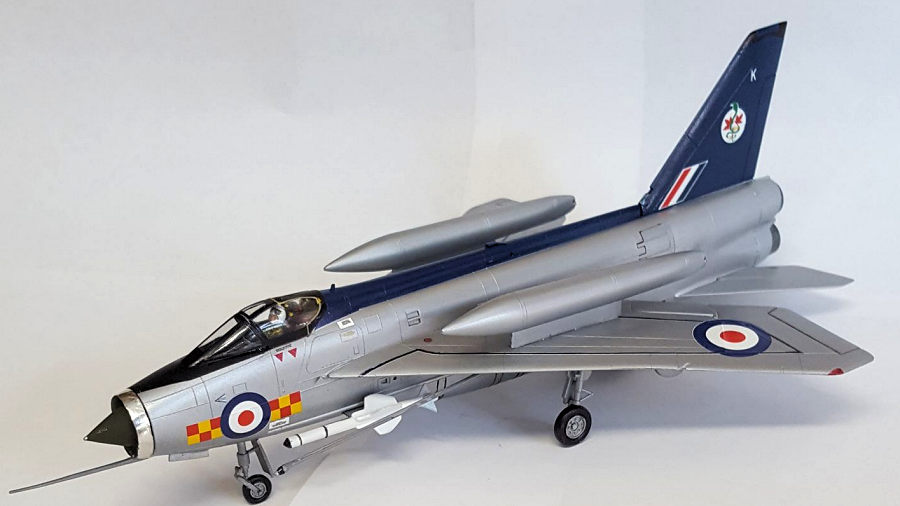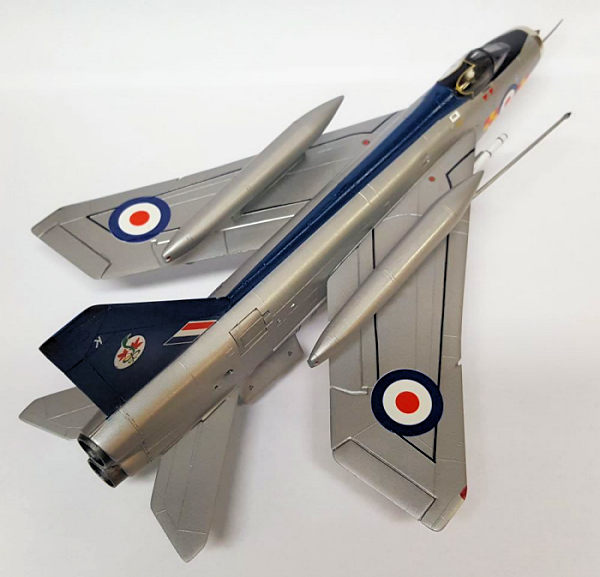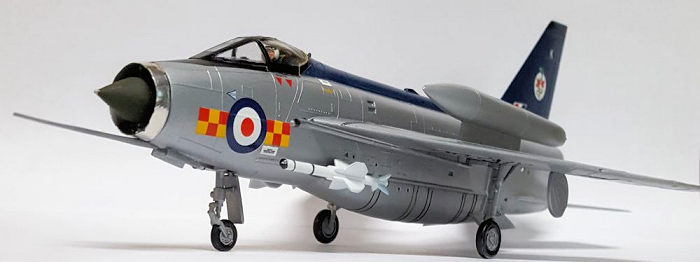
Hasegawa 1/72 Lightning F.6
| KIT #: | ?JS-019 |
| PRICE: | $10.00 |
| DECALS: | Two options |
| REVIEWER: | Chris Mikesh |
| NOTES: | Out of the Box |

| HISTORY |
 (From Wikipedia)
(From Wikipedia)
The English Electric Lightning is a British fighter aircraft that served as an interceptor during the 1960s, the 1970s and into the late 1980s. It remains the only UK-designed-and-built fighter capable of Mach 2. The Lightning was designed, developed, and manufactured by English Electric, which was later absorbed by the newly formed British Aircraft Corporation. Later the type was marketed as the BAC Lightning. It was operated by the Royal Air Force (RAF), the Kuwait Air Force (KAF) and the Royal Saudi Air Force (RSAF).
A unique feature of the Lightning's design is the vertical, staggered configuration of its two Rolls-Royce Avon turbojet engines within the fuselage. The Lightning has exceptional rate of climb, ceiling, and speed; pilots have described flying it as "being saddled to a skyrocket". This performance and the initially limited fuel supply meant that its missions are dictated to a high degree by its limited range. Later developments provided greater range and speed along with aerial reconnaissance and ground-attack capability.
| THE KIT |
 Originally produced around
1967, I expected the kit to be a little more than a lump. The Lightning is one
of Hasegawa’s early efforts into western subjects and started them down the road
of being one of the most distinctive kit producers of all time. My example was
produced around 1973 and was acquired through Rare Plane Detective at a very
reasonable price. The kit is produced in hard silver plastic, very raised panel
lines, and all parts were generally too thick for the scale. But oddly, they do
not detract from the kit.
Originally produced around
1967, I expected the kit to be a little more than a lump. The Lightning is one
of Hasegawa’s early efforts into western subjects and started them down the road
of being one of the most distinctive kit producers of all time. My example was
produced around 1973 and was acquired through Rare Plane Detective at a very
reasonable price. The kit is produced in hard silver plastic, very raised panel
lines, and all parts were generally too thick for the scale. But oddly, they do
not detract from the kit.
What a wonderful surprise! For an early Hasegawa kit, the fit was generally pretty good even though there were few details in the wheel wells or cockpit. As noted in Scott’s review years ago, he purchased a lot of after market updates to the kit. I discovered that most of the updates have been discontinued in lieu of the well-lauded Airfix kit.
The paint scheme was intended to be aluminum with either Royal Saudi Air Force or generic RAF markings.
| CONSTRUCTION |
 This is a great
“entry-Level” model, or a great kit to slam together to try a painting technique
or sharpen some skills. Regardless, in the end, it presents well for whatever
your intention is.
This is a great
“entry-Level” model, or a great kit to slam together to try a painting technique
or sharpen some skills. Regardless, in the end, it presents well for whatever
your intention is.
Construction is very straight forward. Seat, Pilot, 2 fuselage halves and you are well started. After painting the Pilot in the usual flight suit colors, I realized the cockpit was horribly naked. I spent hours trying to find resin interiors unsuccessfully ($20 shipping from some places) I gave up and printed photos of the cockpit from museum aircraft. Actually, I managed to make it fit and looked good for free! But once the canopy is on, you cannot see much of it. At least the Pilot is not suspended over the Grand Canyon!
Next was the nose weight which amounted to 12 BBs super glued under the cockpit. (Thud!) The two fuselage halves were glued together with no fit problems. A little cosmetic sanding on the seams and I realized this kit is going to be something special.
Wings, elevators, and rudder were all one piece molded, but the fit was near perfect. All were glued in place with anhedral on the wings.
The air intake on the nose was going to be a problem. All pictures I’ve seen, showed a well-polished intake ring. I tried to superglue aluminum foil on the ring, but the foil did not stick to the glue. Bare Metal Foil was really my only hope. Due to Covid, my local hobby store was closed so I ordered direct from the folks at Bare Metal Foil and had it in hand in only a few days. (Thank you!) That worked out very well.
There were no other construction issues as the instructions were basic and clear. Photography from active or museum aircraft provided detail information.
| COLORS & MARKINGS |
I opted for the kit markings and aimed at the Royal Saudi Air Force as it was a different country on my shelf and the green markings are an eye-catcher. If the decals failed for some reason, I would have the RAF Decals as a backup.
The canopy was attached
with Elmer’s Glue because it dries clear if used sparingly and parts can be
separated without damage if needed later. After masking the canopy, Tamiya
Aerosol AS-12 Bare Metal Silver was used as the overall silver color. It lays
down beautifully and dries quickly. I recommend it if you are looki ng for a fast
solution to a bare metal scheme. The Nose cone is Tamiya XF-13 J.A. Green, and
the Air Intake ring is Bare Metal Foil Chrome (BMF001).
ng for a fast
solution to a bare metal scheme. The Nose cone is Tamiya XF-13 J.A. Green, and
the Air Intake ring is Bare Metal Foil Chrome (BMF001).
I prepared for a day of decaling only to discover the Hasegawa decals would not separate from the paper. Sadly, the RAF and RSAF decals were ruined. I found a Cutting-Edge RAF decal sheet on line with the extra markings needed for a complete Lightning. While the decals were in route, I needed to paint the spine and rudder dark blue with Tamiya X-4 Gloss Blue.
Also, in the meantime, I had ordered from Model Paint Solutions (https://modelpaintsol.com) some super thin Aizu Micron Masking Tape. Highly recommended! The yellow trim on the canopy is that tape. Also, the black lines on the missiles, wings and belly are different sizes painted black.
I had a variety of detail decals from various kits to replace some of the Hasegawa decals or add detail based on photos.
| CONCLUSIONS |
Simple, quick and attractive. This is one kit that has held its quality over the years. With a little ingenuity and patience, it can be made into a very attractive model. The simple upgrades really made a difference. And who does not like a Lightning!
Please feel free to contact with questions or constructive ideas. ChrisMikesh@Gmail.Com All raised panel lines remain raised!
21 June 2021
Copyright ModelingMadness.com. All rights reserved. No reproduction in part or in whole without express permission.
If you would like your product reviewed fairly and fairly quickly, please contact the editor or see other details in the Note to Contributors.